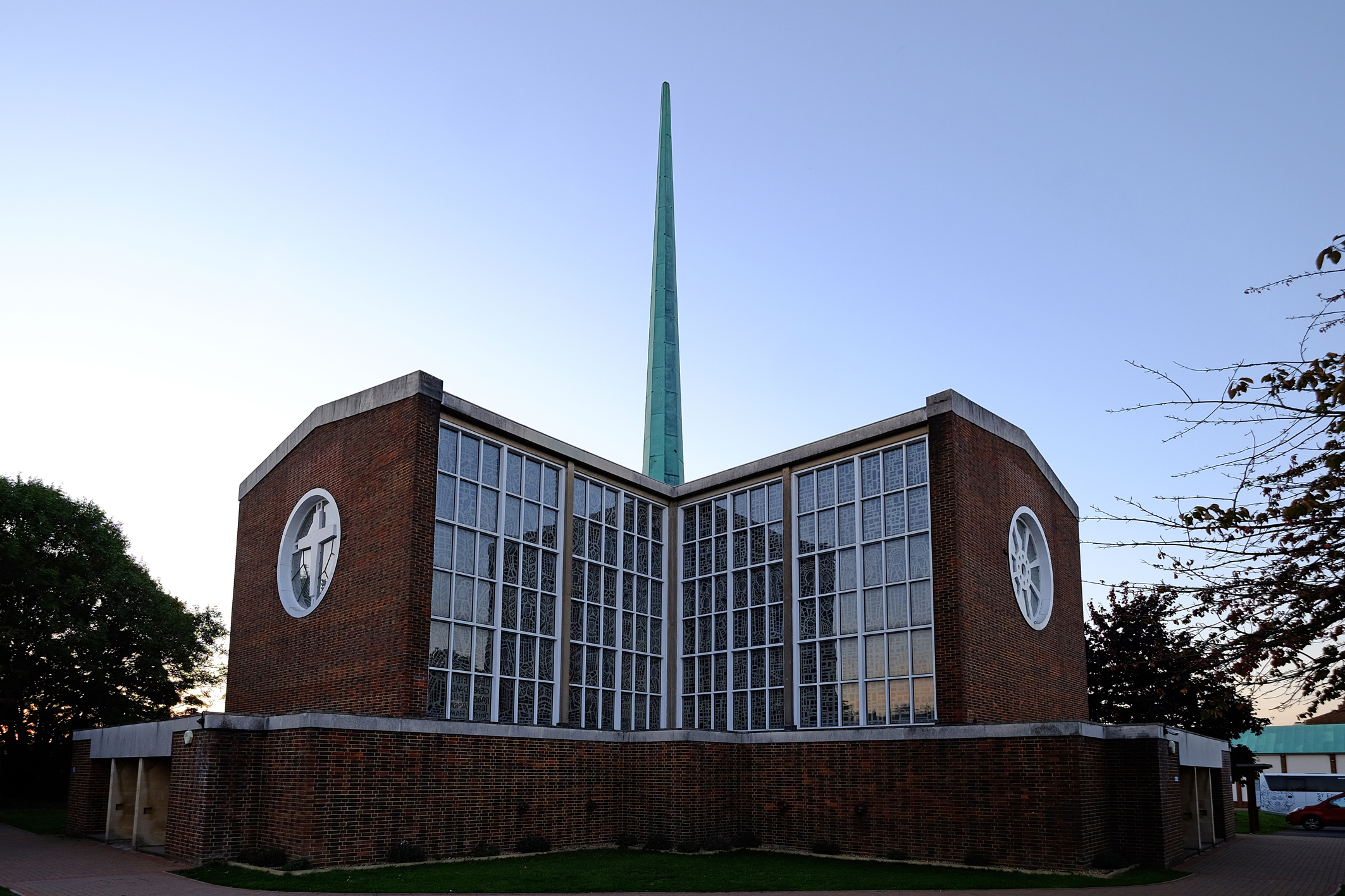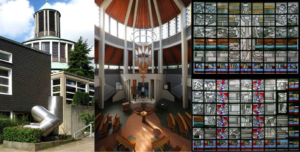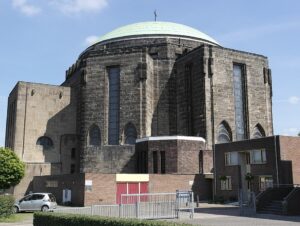
Our Lady of Fatima Parish church in Harlow. © Manuela Klauser.
Churches are places of religious practice and assembly, but they are also shrines of knowledge about Christian rituals and symbols of faith throughout centenaries. Their fine architectures are manifested visions of human environments, relations and communities. Furthermore, most Christian churches want to be understood as open spaces of encounter. The extensive efforts to preserve church buildings and to keep them open for the public even when critics of denominational interpretations and abuse of hierarchical power increase, are signs of a deep cultural-historical bonding to these buildings.
Churches of the 20th century are an important part of this cultural heritage, but hardly known. There is a number of famous 20th-century churches in Europe, built by internationally known architects: for example, the Chapel of Ronchamp (France) designed by Le Corbusier, the Church of the Pilgrimage at Neviges (Germany) designed by Gottfried Boehm or the Sanctuary of Saint Pio of Pietrelcina (Padre Pio Pilgrimage Church) in San Giovanni Rotondo (Italy) designed by Renzo Piano. However, 20th-century churches are a rather young topic in heritage management and protection and generally held in a low esteem.
Form, material configurations and liturgical orientation of contemporary churches changed rapidly and continuously, which made it hard for worshippers and the general public to keep up with understanding these changes. Today, in various European countries are 20th-century churches at risk to be demolished or adapted for other uses. Could it help to understand Christian sacred buildings in the 20th-century as a (still) well preserved cultural landscape? Knowing more about them and the reasons for their comprehensive changes might help to understand a big part of European cultural heritage and history. Especially initiatives in adaptive re-use of churches, trying to link aspects of conservation and aspects of social and cultural candour with each other, are based on the evidence of churches as visionary buildings of community.
The significance of a church building isn’t just defined by its heritage status
The web-based, non-profit German project www.strasse-der-moderne.de, for which I work as an editor, was initiated in 2015 by Andreas Poschmann and his colleagues from the German Liturgical Institute (DLI / https://dli.institute/wp/startseite-institut/ ). Short descriptions for about 200 Catholic and Protestant church buildings of the 20th and 21st century from all German regions can be found on the website. The project doesn’t aim to be or to become an inventory documentation of contemporary church architecture. It is run like an online exhibition regularly updated and supplemented. Furthermore, it works like a didactic instrument to learn more about Christian architecture of the past 120 years and to better understand the reasons for material, construction and room concepts, which are still perceived as foreign. The detailed and simply phrased architectural and theological descriptions are also useful on site – in the church – as a short travel guide to discover the artistic richness and intellectual complexity of a place. Unfortunately, the website is currently just available in German, but the project is recognized as an important source to introduce the topic to a touristic environment as key to increase the level of public acceptance.

Church of the Resurrection (Auferstehungskirche) in Essen, Germany. © Photo 1 (left): Volker Wagenitz. © Photo 2 (middle): Florian Monheim. © Photo 3 (right): Research Center for Glass Painting of the 20th Century e. V.
Unlike similar projects in other countries, Strasse-der-Moderne does not only report listed buildings. An advisory board consisting of experts from Architecture, Theology and Art History regularly discusses objects at disposal. The displayed churches should still be in use. Meanwhile, individual buildings are taken out of use ore are in adaptive re-use, therefore it will be necessary to update this concept soon.
- Churches are described in short texts and presented with a range of photographs and a floor plan.
- The texts – mainly written by art historians and theologists – outline touristic aspects, the building history, its significance, artistic works on site and architectural features.
- Supplementary information about many architects and artists can be looked up in an extra database.
- Several possibilities to search for objects invite the users to discover a particular region or city or an architect/artist: Full text research is the quickest way to find an already known object, but one can also use a range of filters (name of a town, region, time period etc.) or a local search via map which shows all captured churches and chapels within a defined radius.
It is the personal stories, which turn the churches into places
Visiting 20th-century churches always means becoming surprised by discovering the place, the space and of course by meeting the people who care for the places. Usually, it is necessary to make appointments for a visit, since many of them are parish churches which are no longer in regular use and often locked. I regularly visit contemporary churches in the Netherlands, in France, Belgium and Germany as well as occasionally in other European Countries. Every place has its unique charm. The people on-site always meet me and my colleagues with great kindness and frankness and it is always good to hear the stories about the history of a place rather than just knowing the historic facts – the stories turn these buildings into places!
Several years ago, I planned a trip to the Church of the Sacred Heart of Jesus (Heilig Haart Kerk) in Maastricht. Also known as Koepelkerk, it was built in 1921 by Dutch Architects Alphons Boosten and Jos Ritzen for the Congregation of the Priests of the Sacred Heart of Jesus (Dehonians). The vast dome made of Concrete is one on the earliest examples of a centralized sacred space in modern material and technique. The Dutch priest Cornelis Hubertus Luyten, who helped to plan the church, pointed out the dome as a symbol of the community of church and parish. When making an appointment to visit the church, all I received was the number of a person who didn’t speak English (while I don’t speak Dutch). Via translation app and SMS we arranged a time to meet but I wasn’t sure if it would really work. What a surprise to find not less than three volunteers who awaited us eagerly – they had even found somebody for our group to guide us in English! It was amazing to discover this church which is so rarely open to the public and keeps so beautiful stained glass windows, frescoes and an amazing altarpiece besides the gorgeous architecture!

Church of the Sacred Heart of Jesus (Koepelkerk) in Maastricht, The Netherlands. ©Kleon3
Sometimes I am lucky enough to find a way into a locked church without an appointment: these moments not only fill me with excitement but also with gratefulness. A few weeks ago I visited together with a colleague a small Catholic church in a northern suburb of London: Our Lady of Fatima Parish church in Harlow, designed by Gerald Goalen in 1954 and built between 1958 and 1960. The amazing stained-glass windows in concrete (Dalle de Verre technique) are designed and made by Dom Charles Norris OSB of Buckfast Abbey and are absolutely unique! I had planned this trip long before the Pandemic started and was rather excited to finally see this place, but couldn’t make contact to the parish in time. When we I arrived in the early evening, the church was of course locked but we were lucky to meet somebody around who showed us where to find the priest. Although he was just preparing his dinner, we received a very warm welcome. He happily showed us the church and the windows, gave us some documentation material and told us about the situation of the church only a few years ago. In 2001 and again in 2017 it was closed due to safety concerns of the architecture but a way to fix the problems and to re-open the church was always found – what luck! The centralized liturgical space and the Dalle de Verre windows are important examples of Britain’s contemporary church architecture. The building is Grade II listed and absolutely worth a visit. We felt like standing inside a jewel with the huge stained glass walls surrounding us!
Let me conclude these private experiences with the recommendation to all of you to just start discovering church buildings which are not described in popular travel guides! Artefacts and furnishing of 20th-century churches teach us a lot about architecture, sculpture and painting as much as about applied arts during the 20th century. They are important sources of art which wasn’t made for trading or for private purposes but for the public view and reception. Although 20th-century churches still have no general reputation as cultural heritage, there are a lot of people who take care of them. Not only do the churches and their precious equipment gain our respect and protection but also their guardians.
Dr. Manuela Klauser, Art Historian, Editor of the web-based project www.strasse-der-moderne.de and scientific assistant for the DFG-project Sakralraumtransformation (Transformation of sacred space) based at the University of Bonn; author of several publications on European sacred architecture in the 19th, 20th and 21st century.





Follow us: